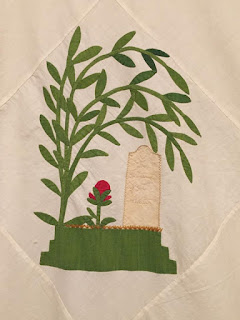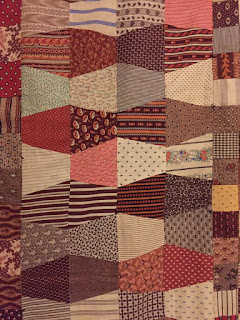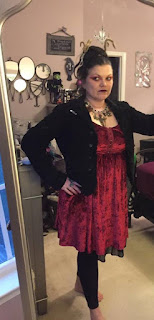Longing and desire goes further
than instant satisfaction.
That's human nature.
~Anna Sui
 |
| Kentucky Requiem: A
Quilter’s Gathering ca. 2014 |
It’s
been about a month since the Virginia Quilt Museum (VQM) Seminar, Mourning and Meaning
Through Cloth: A Textile Study, a special two-day conference on
death and mourning in America, which focused on American rituals of death and
grieving as shared through the lens of quilts, mourning dress, and historic
textiles. Regardless of the time, that seminar still sticks with me.
While
the first day (which I
wrote about here) focused on the symbolism of death depicted in mourning
jewelry and gravestones, and how these symbols were also found in historic
quilts, the second day of the seminar focused exclusively on textiles with
lectures focusing on mourning dress, samplers, and macabre quilts. The three
lecturers also work in positions as public historians.
The second day of the seminar included a lecture by
Karin J. Bohleke, Director of the Fashion Archives & Museum of Shippensburg
University, PA, an avid seamstress, embroiderer, and lace-maker. Her lecture
was titled, "The Mourning After: Fashioning Grief in the 19th
Century.” Bohleke, whose presentation included images of Victorian women in
mourning attire, began with an overview of the general terminology associated
with mourning along with the intricate stages of dress.
 |
| a mourning dress with a tiny waste on display |
She discussed how in “general mourning,” that which
includes all citizens and not just royalty, the middle class was often quite
concerned about making social missteps considering there were so many differing
views from various sources; and, they were also concerned about the financial
burdens of participating in the culture.
For the most part, one’s economic status determined
one’s ability to participate in the culture. Depending on the availability of
funds, one would dye clothing, add a black collar, or add a black brooch.
Participating in mourning became a serious financial burden especially for
women who not only had lost a loved one but who perhaps also lost a source of
economic support. In such situations, the woman was required to change her
clothing, or alter it, to meet the society expectations of mourning dress; and,
she also was required to provide a meal. Bohleke shared stories of women who
used their last coins, which should have been kept to purchase food, on
mourning dresses.
Black material was expensive and it was also
unstable, which Bohleke emphasized meant that it was “not washable.” The dye
would rub off on one’s skin which posed an additional concern since it was
difficult to wash off and, at times, the chemicals caused a health risk. Talk
about a goth girl’s nightmare!
 |
| a portion from New York Album quilt ca. 1850 |
With Americans following European fashion,
“fashionable mourning” attire could economically ruin a family since the veil
lengths, fabrics, and types of black varied from season to season.
American women began viewing the European mourning
fashion as an unnecessary expense and pushed back against the culture by
transforming their clothing into mourning attire and even repurposing their
mourning attire, which led to secondhand clothing stores featuring mourning
attire becoming a feasible business opportunity.
Bohleke concludes that in spite of the negative
aspects, Victorian mourning traditions represent a profound understanding of
the nature of grief. In her paper, she emphasizes, “…mourners realized that
grief requires time, and they generously allotted that time. The specialized
and standardized clothing generated instant comprehension that required little
or no explanation in order to elicit sympathy” (190).
The second lecture, “Memorial Pictures &
Samplers” was from Sheryl DeJong a representative from the Smithsonian
Institute National Museum of American History Textile Collection. The first sampler
was donated in 1886 and is known as the Margaret Dinsmoor sampler. The earliest
dated sampler in the collection was made in 1735 by Lydia Dickman of Boston,
Massachusetts.
 |
| a portion of Deep Within My Heart Lies a Melody a Memory of Texas, Polly Mello ca. 2011 |
DeJong explained that samplers have become
important in museum collections as representations of early American female
education. Many of the 137 American samplers in the Smithsonian collection are
signed, and some are inscribed with locations and the names of teachers and
schools. DeJong noted that young girls would learn needle-work before they
would learn how to read or write. If the girl finished her sampler, she might
move to a higher level of school such as silk painting.
In many of the examples, DeJong pointed out that
some type of reference to George Washington was included not as a sense of
mourning but because it was popular and fashionable; it was not intended to be
sad. And, just as the VQM prepared a pamphlet “Design on Stone: Symbols of
Mourning and Remembrance” for the two-day seminar with “the objective to
connect symbols used on tombstones of various eras to quilt patterns and
quilting”, noting that “the symbols are often found on both [gravestones and
quilts] and reflect the design of the period” (VQM), DeJong emphasized that
many of the symbols, such as weeping willow trees and urns, are included in the
samplers.
 |
| a portion of Two Side Coffin Drape ca. 1860 |
Finally, the seminar keynote speaker was Polly
Mello, a quiltmaker-historian, collector, independent scholar and curator. She
shared her antique and contemporary quilts from her collection, “Midnight in
the Garden of the Quilt.” This collection includes mourning quilts, coffin drapes,
quilts devoted to presidential assassinations and other headlines, and crib
quilts from the 1840s to 2016.
There were so many amazing quilts. For now, I should probably just limit myself to focusing on one so I will write about one of the highlighted quilts, “Kentucky Requiem:
A Quilter’s Gathering”, a reproduction of the infamous Kennedy Graveyard
Quilt often known simply as “the graveyard quilt,” which Mello argues, “…is the
most famous mourning quilt in the country and one of the most recognized quilts
in American Quilt History” (Exhibition 1).
The graveyard quilt dates to 1843. It is housed in
the Kentucky Historical Society's (KHS) Thomas D. Clark Kentucky History Center
in the Nina Mitchell Collection. It is an album quilt meaning that it
includes signatures of those who made the quilt so historians know that it was created
by Elizabeth Roseberry Mitchell with help from her two daughters. The quilt was
passed down through the family to Nina Mitchell Biggs who donated it to the KHS
in 1959.
 |
| a portion of Broken Blossom quilt top |
Made of cotton fabrics in shades of brown, the
quilt includes stars alternating with blocks of fabric. In the center there is
a scene of graves, presumably a family plot, surrounded by a picket fence with
climbing roses. There are coffins inside the fence and as well as along the
border of the quilt where there is another picket fence. Names of several
family members are attached to some of the coffins on small strips of paper
both inside the center picket fence and around the border of the quilt (KHS).
Mello, in “Conversations on Midnight in the
Garden of the Quilt Exhibition” writes, “Elizabeth Mitchell is said to have
had to leave behind the graves of two sons when she moved to Kentucky. She made
the quilt from the school clothes of the sons”(1). Mello explains that this was
intended to be an “interactive quilt” since the coffins were labeled with the
names of family members. She presumes that when someone died, their coffin
would be moved into the family plot in the center of the quilt. She argues, “Caring
for family graves was very important in the 19th century. With this
quilt, Elizabeth was able to care symbolically for the family graves”(1).
 |
| a portion of Gashlycrumb Tinies, Mello, ca. 2016 |
KHS affirms, “This quilt is an excellent example of
nineteenth century mourning customs as well as an illustration of the emotions
and experiences that were often expressed by women through their quilts.” In an
interview, Julie Kemper, curator of the Kentucky Historical Society's Museum
Collections and Exhibitions explains that mourning customs in the 1840s were
different than today but during the time of the making of the quilt, the
symbols used most frequently for mourning quilts included angels, weeping
willow trees, and wreaths. A graveyard design in a mourning quilt is rare
and the quilt maker’s design was fairly unusual (Toncray).
Because the graveyard quilt is only occasionally
put on display and it is so renowned, Mello knew that she could never be able
to purchase the quilt to add to her own collection; instead, she paid tribute
to the quilt by making a reproduction. It is a traditional reproduction in how
it is made; she explains that her 2014 Kentucky Requiem: A Quilter’s Gathering “is
made entirely by hand, as it would have been made in the 1840s” noting that it
is hand appliqued, hand pieced, hand embroidered, hand quilted and hand
constructed. With Mello’s reproduction quilt she even emphasizes that instead
of family members, she includes the names of her quilt friends noting, “We will
all be ‘buried’ together on the ‘Kentucky Requieum’ quilt” (1). Okay, this
makes me tear up each and every time I think about this. It is such a beautiful
gesture and acknowledgement of such profound friendships.
Bohleke, DeJong, and Mello have all reconstructed a
glimpse into the past through the interpretations of clothing, samplers, and
quilts. The individual stories of each piece that they shared speak to the
larger community of the time. The artifacts serve as a bridge to connect us with
the past and with our American history.
The seminar has passed but VQM will have Polly Mello's exhibit on display until December 17th. All of the pictures from this post were taken at VQM by me during the seminar. For more details about the exhibit, you can visit the museum website.
Works
Cited
Bohleke,
Karin J. "The Mourning After: Fashioning Grief in the 19th
Century." Mourning and Meaning Through Cloth: A Textile Study. Virginia
Quilt Museum, Harrisonburg. 22 Oct. 2016. Lecture.
Bohleke,
Karin J. "Identifying Stages of Grief in Nineteenth-Century Images." The Daguerriean
Annual (2015): 166-191. Print.
DeJong,
Sheryl. "Memorial Pictures & Samplers." Mourning and Meaning
Through Cloth: A Textile Study. Virginia Quilt Museum, Harrisonburg. 22 Oct.
2016. Lecture.
Dickey,
Colin. Ghostland: An American History in Haunted Places. New York:
Viking, 2016. Print.
Didawick,
Lauren, comp. The Virginia Quilt Museum Presents Conversatons on Midnight in
the Garden of the Quilt Exhibition. Harrisonburg: Virginia Quilt Museum,
2016. Print.
Friend,
Craigh Thompson, and Lorri Glover. "Introduction: Death and the American
South." Death and the American South. New York: Cambridge UP, 2015.
1-14. Print.
Mello,
Polly. "Conversations on Midnight in the Garden of the Quilt
Exhibition." Virginia Quilt Museum, Harrisonburg. September 2016. Print.
Mello,
Polly. "Exhibit Gallery Walk." Mourning and Meaning Through Cloth: A
Textile Study. Virginia Quilt Museum, Harrisonburg. 22 Oct. 2016. Lecture.
Mello,
Polly. "Quilts that Go Bump in the Night." Mourning and Meaning
Through Cloth: A Textile Study. Virginia Quilt Museum, Harrisonburg. 21 Oct.
2016. Tour.
Sayer, Faye. Public History: A
Practical Guide. New York: Bloomsbury, 2015. Print.
Simon Thurley, Into the future.
Our stategy for 2005-2010. In: Conservation Bulletin [English Heritage],
(49). Web.
Summer 2005.
"The Value of History: Seven
Ways It Is Relevant." History Relevance Campaign. N.p., n.d. Print.
Toncray, Marla. "Rare
Graveyard Quilt Crafted by Lewis County Woman." Ledger Independent.
N.p., 15 Jan. 2015. http://www.maysville-online.com/
Web. 26 Nov. 2016.
"Virginia Quilt Museum:
Celebrating and Nurturing Virginia's Quilting Heritage." The Virginia
Quilt Museum. The Virginia Quilt Museum, n.d. http://www.vaquiltmuseum.org/
Web. 05 Nov. 2016.
Virginia
Quilt Museum brochure. Harrisonburg: Virginia Quilt Museum, 2016. Print.
Virginia
Quilt Museum. Design on Stone: Symbols of Mourning and Remembrance....
Woodbine Cemetery. Harrisonburg: Virginia Quilt Museum, n.d. Print.

















